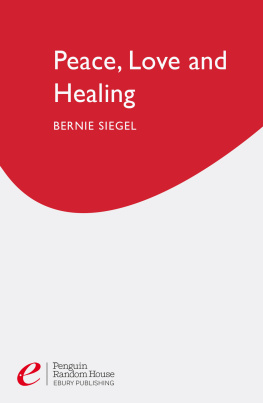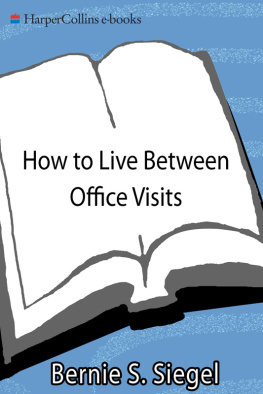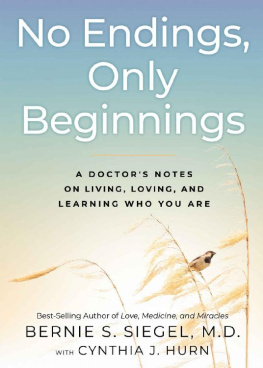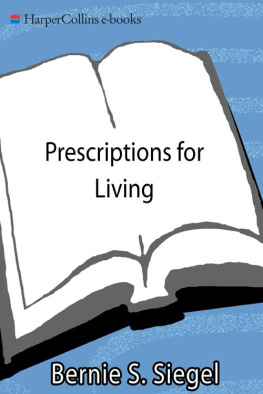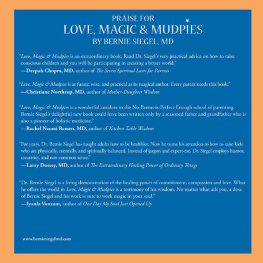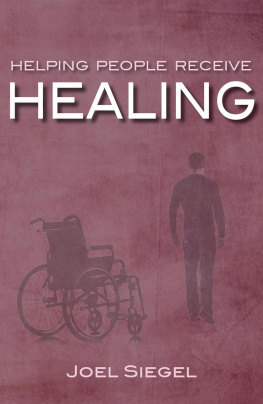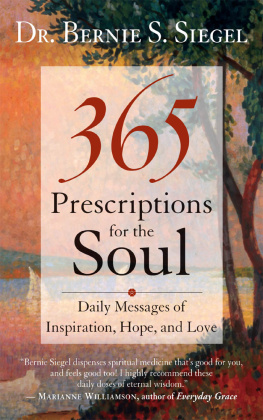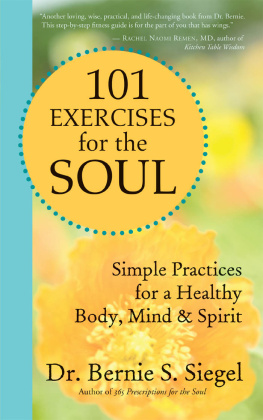Contents
About the Author
Bernie S. Siegel attended Cornell Medical College and then trained as a pediatric and general surgeon at Yale New Haven Hospital and the Childrens Hospital of Pittsburgh. In 1978 he founded ECaP (Exceptional Cancer Patients), a form of individual and group therapy which encourages personal change and healing. He has written three books since 1986, including the huge bestsellers, Love, Medicine and Miracles and Peace, Love and Healing. Now retired as a surgeon, he lives in Connecticut and lectures widely all over the world.
About the Book
Full of inspiring stories of patients who have achieved remissions and miraculous cures for illnesses such as mulitple sclerosis and cancer, Dr Siegel shows us how emotions such as love, hope, joy and peace of mind have strong physiological effects on each of us, as do depression and dispair. Peace, Love and Healing teaches us to be receptive to the messages our mind gives our body through dreams and symbols, and how to view illness as a reset button enabling us to redirect our lives. Equally importantly the book explains how to give your body healing messages through the use of meditation, visualization and relaxation. Although the important role of modern medicine is recognised, Bernie Siegel offers us many examples and case studies of the remarkable results that we can achieve through body-mind communication and reiterates his essential point that love heals.
1
I have the conviction that when physiology will be far enough advanced, the poet, the philosopher and the physiologist will all understand each other.
C LAUDE B ERNARD
The Physiology of Love, Joy and Optimism
IN JANUARY OF 1983 John Florio, a seventy-eight-year-old landscape gardener, was contemplating retirement. He developed abdominal pain and underwent a GI series, which showed an ulcer. He was treated for one month and re-x-rayed to see if the ulcer had healed. This time, however, it was larger and looked malignant. A biopsy revealed cancer of the stomach.
I first met John in late February when he was referred to my office for surgery. I suggested to him that we get him into the hospital right away since I was going on vacation, and I thought that with a rapidly advancing cancer he ought to have surgery immediately. He looked at me and said, You forgot something. What did I forget? I asked. Its springtime. Im a landscape gardener, and I want to make the world beautiful. That way if I survive, its a gift. If I dont, I will have left a beautiful world.
Two weeks after my vacation, he returned to the office, saying The world is beautiful, Im ready. He looked incredibly well the night after his surgery, with no pain or discomfort. The pathology report revealed: Adenocarcinoma, poorly differentiated, invasive through gastric wall and into perigastric adipose tissue. Proximal margin involved by tumor, seven of sixteen lymph nodes positive for tumor. That simply meant he still had a lot of cancer left in him after the operation. I explained to him that he ought to consider chemotherapy and x-ray therapy to deal with the residual cancer. You forgot something, he said. What did I forget this time? Its still spring. I dont have time for all that. He was totally at peace, healed rapidly and was out of the hospital well ahead of schedule. (His granddaughter, an oncology nurse at Yale, was fully aware of the findings and his choice.)
Two weeks later he was back in my office, complaining that his stomach was upset, and I thought, Aha, its the cancer again. It turned out to be a virus, which I treated symptomatically, and he left my office.
In March of 1987 I arrived at my office and saw Johns name in the chart rack. You must have the wrong chart, I said to the nurse. No, thats the right chart, she said. Then there must be two people with the same name. No, no, she insisted, hes sitting in there. Then I showed her his pathology report to explain why I assumed she had made a mistake. If you think pathology reports predict the future for an individual, it wouldnt seem possible that I could be seeing John four years after his operation. But thats who I saw when I walked into my examining room.
I again feared that his visit would be related to cancer. Before I could ask him anything, the first words out of his mouth were Dont forget, this is only my second postoperative visit. I think he wanted to make sure the insurance would cover it. But why are you here? I asked. I have a question, he said. Id like to know what you can eat after a stomach operation. Four years after, anything! But tell me, why are you here? I have a hernia from lifting boulders in my landscape business. Since he refused to be admitted to the hospital, I repaired it under local anesthesia on an outpatient basis, and he was off and running again. If he rested at all Id be surprised, even though he promised to have two young men do his normal work the first few weeks after surgery.
John is one of those exceptional patients who seem to most clinicians to defy understanding. But I have learned that all of these exceptional patients have stories to tell and lessons to teach. Its not just a matter of being lucky or having well-behaved diseases (slow-growing tumors, spontaneous remissions and so forth). What you have to understand is that there is a biology of the individual as well as a biology of the disease, each affecting the other. On the day of diagnosis we dont know either well enough to use a pathology report to predict the future.
It is now six years after his surgery, and John celebrated his eighty-third birthday recently. You have to wonderwhat has happened to his cancer?
I dont know if his immune system eliminated it or if its still in there, enjoying Johns life so much that its going along for the ride. What I do know is that when you look at John what you see are signs of his ability to live and love. Still passionate about his lifes work, he sends me letters with clippings about the therapeutic value of the outdoors and an article about himself in the local newspaper that quotes him as saying If I find a little marigold just lying there, I feel so sorry for it I just put a hole in the ground with my finger and plant it. The article ends by saying Today... John is still on the job, planting and pruning. He loves it. And like the legendary cowboy who proudly professes he wants to die in the saddle with his boots on, he says when his turn comes I always pray that Ill die at work, gardening.
Working outdoors, John maintains what I call a celestial connection, and, like patients in the hospital who have been shown to heal faster when their room has a view of the sky, he is healthier because of it. John is too busy living to be sick. Thats his real secret. But how, in scientific terms, do we account for him? What can we learn from him? Is there really a physiology of optimism, peace, love and joy?
SELF-INDUCED HEALING
Spontaneous remissions like Johns I prefer to call self-induced healings. They make wonderful anecdotes and can also tell us a lot about communication between mind and body. But since most people dont believe in the existence of these remissionserror in diagnosis or well-behaved disease is the standard explanation for themthere hasnt been much of an attempt to understand them scientifically. The medical profession always gives the credit to the disease rather than the person. We need to start studying the person and success.
The Remission Project of the Institute of Noetic Sciences in Sausalito, California, is now trying to fill the vacuum by analyzing four thousand medical journal articles on the subject of spontaneous remission from all over the world. Since any given article can cover multiple cases, many more than four thousand cases are involved, in addition to which the project is also looking at extraordinary healings such as those that have occurred at Lourdes.
Next page
